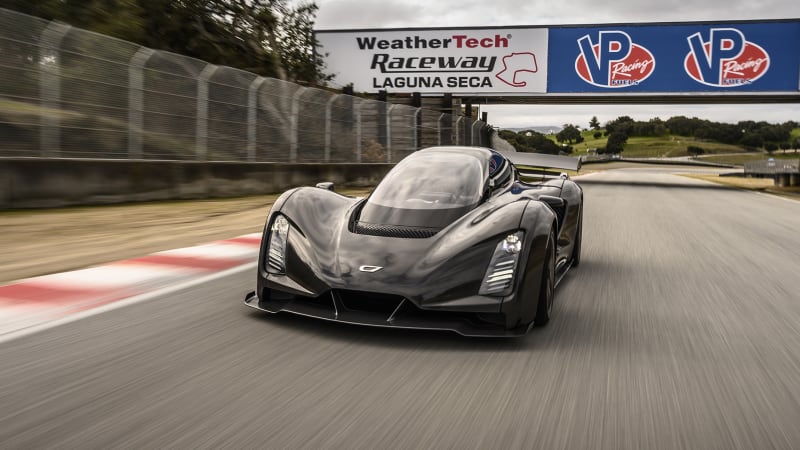
Los Angeles-based startup Czinger has remained relatively quiet since it unveiled the 21C, a 3D-printed plug-in hybrid hypercar, in February. Its plans to present the model at the 2020 Geneva auto show were derailed when the event was canceled, and it decelerated its operations to comply with California's COVID-19-related lockdowns, but work never stopped behind the scenes. We caught up with the brand to get a better idea of where it stands.
Jens Sverdrup, the young brand's chief commercial officer, told Autoblog engineers began testing prototypes on the road and on the track in August 2019. "This is not one of these stories where you see new companies coming out with a mockup or a computer rendering; we have fully functioning cars, and we've spent a significant amount of money on them," he said. Testing abruptly stopped in the spring, fine-tuning a 1,233-horsepower car wasn't considered an essential activity, but the data gathered in late 2019 and in early 2020 was encouraging.
"We know enough about the car's performance to say our numbers are conservative," he explained. "We have a lot of work to do in the area of refinement, but we haven't experienced any major issues. Our car is well designed and well thought-out. We have test rigs, so the chassis had gone through [about 280,000 miles] of testing before we even started test-driving the car," he added. Building a car that goes really fast in a straight line and around a bend is relatively easy compared to making it comfortable and docile to drive around town. Czinger wants the 21C to tick the speed and refinement boxes, because the market for bludgeon-like supercars no longer exists.
On-road testing stopped, but development continued. Czinger's engineers didn't spend the lock-down period playing Mario Kart on the Wii. Sverdrup revealed the company's research and development department made several small changes, like improving the 21C's downforce and shedding weight. It's too early to tell how these tweaks will affect the car's zero-to-60-mph time, which is pegged at 1.9 seconds, or its 268-mph top speed. However, he stressed the firm funds product development on its own instead of using deposits to pay for it.
"We've not been chasing deposits to fund our R&D. This approach makes us very different from many of the other brands we tend to be compared to. It feels really good not to [rely on deposits]. It means we believe in what we're doing, we're not fishing for interest, and we're committed to doing this. We've invested the money up front; this is serious," he noted.
Czinger should have shown the 21C in motion for the first time at the 2020 edition of the Goodwood Festival of Speed, and it had invited a handful of journalists to take it for a spin, but the event was canceled. What's next depends largely on the pandemic's evolution, and whether lock-downs are once again enforced around the world. Production likely won't start in 2021 as planned, Sverdrup told Autoblog 2022 is more likely, and the delay was inevitable considering the circumstances. Rivian -- which has the keys to Amazon's bottomless purse -- had to push back R1T and R1S production until 2021 for the same reason, and even established companies like Chevrolet are struggling to deliver products on time. It won't have time to build every 2020 Corvette ordered.
2020 is the wrong year to launch a car, or really anything that's not a vaccine or a mask. Czinger takes comfort in the fact that most of the enthusiasts and potential customers who have seen the 21C so far have liked it.
"Response to the 21C has been overwhelmingly positive. We've seen some skepticism, of course. We're a new brand. It's up to us to be consistent, prove ourselves, and keep pushing to deliver good cars," Sverdrup stated with a dose of realism we've rarely heard echoing through the automotive industry's start-up corner.
Czinger will cap 21C production at 80 examples, but it doesn't plan to stop there. It's in the process of recruiting dealers, and they wouldn't be doing that simply to sell 80 cars. While Sverdrup stopped short of telling us what's next, he confirmed there are follow-up models in the pipeline. All will be quick, light, and exclusive, though some will be positioned below the 21C, which carries a base price of $1.7 million. "It's not hypercar pricing, but it's also not the Ford Mustang," Sverdrup said.
And, regardless of what the company builds next, it will be manufactured using a 3D-printing technique developed in-house. It saves a tremendous amount of time and money by eliminating the need to design and manufacture tooling before launching production of, say, a suspension arm.
"It's the future," Sverdrup said. "I would be very surprised if, in 20 years, this is not the way cars are built."
[ad_2]
Source link
